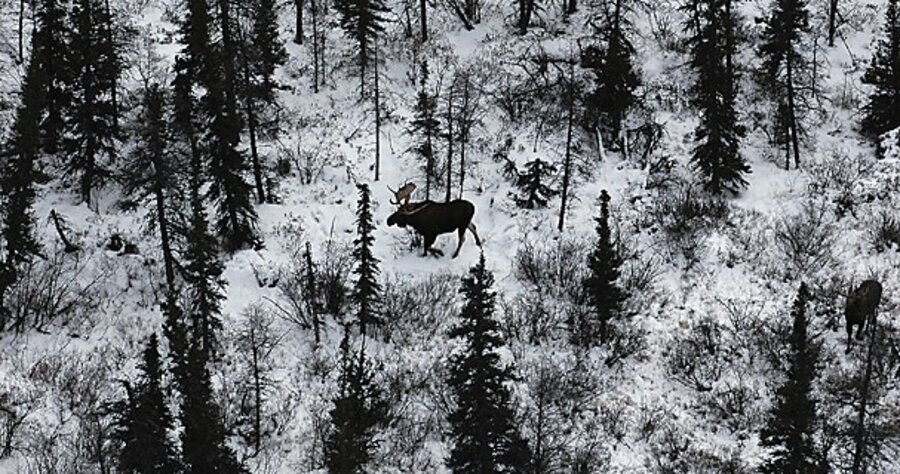Surprise: Old-growth forests soak up CO2
Loading...
The concept seems simple: Enlist key developing countries in the fight against global warming by paying them with carbon credits to not cut down their tropical forests. In international climate talks, the idea has gained a lot of traction.
But some forest ecologists are figuratively tugging on negotiators’ sleeves and saying: “Don’t forget forests at higher latitudes.” It may be time to give countries with large intact temperate and boreal (far northern) forests credit for forest preservation as well, they say.
It’s not clear how much traction this policy prescription could have. Whether and how to account for forests’ roles in slowing global warming – forests in wealthy, developed countries, that is – has long been contentious.
Giving developed countries a credit-for-preservation deal doesn’t erase the principle that different countries have different responsibilities for tackling climate change, says Sebastiaan Luyssaert, an ecologist at the University of Antwerp in Belgium. But “when primary forest landscapes provide much-needed services to mankind, this should be accounted for, irrespective of country.”
From the atmosphere’s perspective, “a pulse of CO2 has the same warming effect, irrespective of the GDP of the forest” from which it came, says Brendan Makey, an ecologist at the Australian National University in Canberra. According to the Intergovernmental Panel on Climate Change (IPCC), “we need to be well below zero emissions by 2100,” he says. And in order to stabilize concentrations of greenhouse gases in the atmosphere, “we do not have a choice ... but to halt emissions from deforestation and degradation – and in fact begin to restore the terrestrial carbon stock.”
Setting up a system to give developing countries credit for tropical-forest conservation is seen by many as low-hanging fruit in the struggle against climate change. Some 90 percent of global deforestation – responsible for 20 percent of all human-caused CO2 emissions – occurs in 24 tropical nations.
Such a system would reward poor countries with a financial incentive to reduce deforestation. Developed nations, facing the prospect of tighter greenhouse-gas emissions, would be eager to buy carbon credits tropical countries earned this way.
For tropical countries, the sale of carbon credits could bring in from $2.2 billion to $13.5 billion a year, based on the value of the credits on international carbon markets, according to a study published early this year in Britain’s Philosophical Transactions of the Royal Society B.
Now new research suggests that some of the world’s oldest forests at higher latitudes soak up CO2 far longer than previously believed. Belgium’s Dr. Luyssaert says the initial exclusion of these forests in carbon accounting assumed that such old-growth forests gave off through respiration as much CO2 as they took in through photosynthesis. They were thought to be carbon-neutral – based on a 1969 study that measured one forest at the beginning and the end of a 10-year period.
Half of the primary forests on the planet grow in temperate and boreal areas. These forests, which include old-growth forests, lock up some 1.3 billion tons of carbon a year, according to recently published research conducted by Luyssaert and colleagues from the United States, Germany, Switzerland, France, and Britain. Forests that are 200 years old or older within those primary forests continue to sequester an estimated 2.4 tons of carbon per hectare (about 2.5 acres) each year. The results appeared in the Sept. 11 issue of the journal Nature.
Indeed, earlier this summer, Canada’s Ontario province took a huge step in preservation by setting aside 55 million acres of its boreal forests for protection. While details remain to be worked out, the move drew praise from a wide range of scientists. Canada took the move in no small part because of the “carbon sink” the forests represent. The forests have locked up a lot of carbon in vegetation and soils.
Meanwhile, in Australia, Dr. Makey finds that both the Australian government’s carbon-accounting approach as well as that of the IPCC underestimate the amount of carbon locked up in Australia’s intact natural forests. If left undisturbed, the country’s eucalyptus forests would retain 9.3 billion tons of carbon, versus the 3.1 billion tons the IPCC estimates is there, he claims.
While noting that the work on old-growth forests is “an important scientific study” for what it reveals about primary and old-growth forests, the policy prescription – at least as it applies to developed countries – is the wrong way to go, says Andrew Weaver. He’s a climate modeler at the University of Victoria in British Columbia and a lead author for the IPCC’s latest series of reports on global warming.
“The danger is trying to get credit for doing nothing,” Dr. Weaver says. In 1997, “we might have been able to argue that,” but emissions have grown so much since then “that we can’t do that anymore.”
Still, in a post-Kyoto agreement, temperate and boreal forests in developed countries could well be viewed as a potential source of CO2, “to be managed like any other source,” says Nigel Purvis, a visiting scholar at Resources for the Future in Washington. And while that probably won’t include credits for avoided deforestation for developed countries at the international level, “under the domestic laws of these countries, there needs to be positive and negative incentives to manage emissions and the carbon stock” in their forest sectors.





